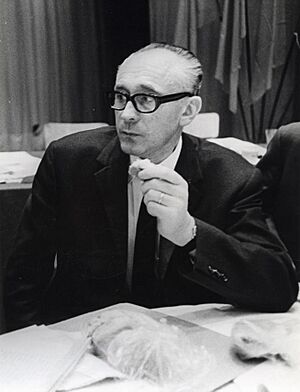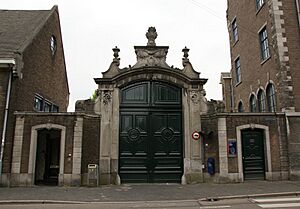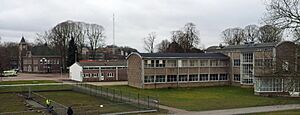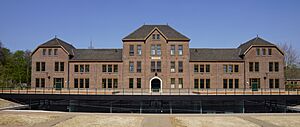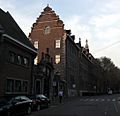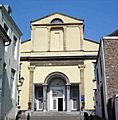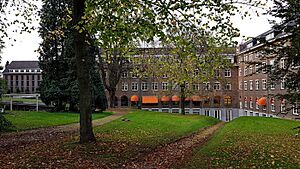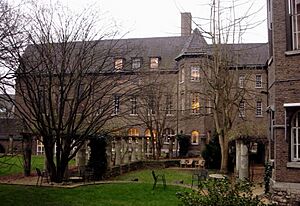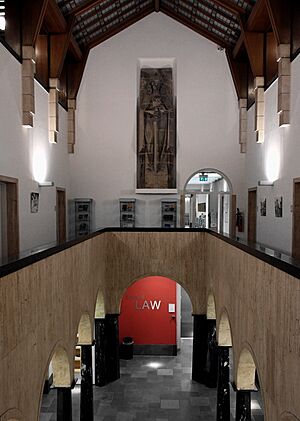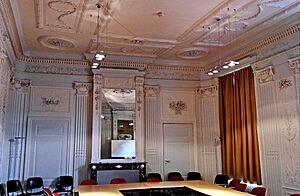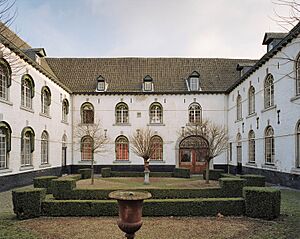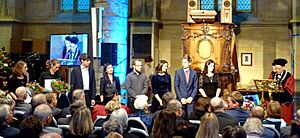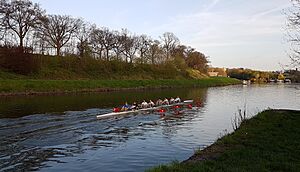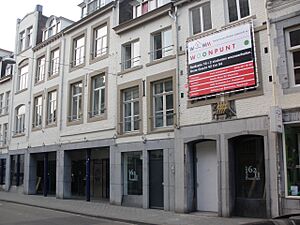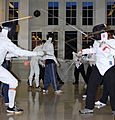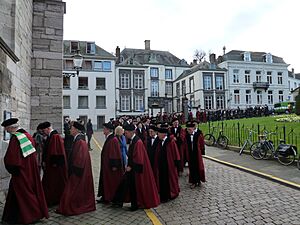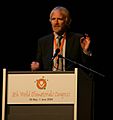Maastricht University facts for kids
|
Universiteit Maastricht
|
|
 |
|
|
Former names
|
Rijksuniversiteit Limburg |
|---|---|
|
Motto in English
|
Leading in Learning |
| Type | Public |
| Established | 9 January 1976 |
| Endowment | €521 million annual income |
| President | Rianne Letschert |
| Rector | Pamela Habibović |
|
Academic staff
|
2,539 (2023) |
|
Administrative staff
|
1,964 (2023) |
| Students | 22,976 (2023) |
| Location | , |
| Colours | Dark blue and white |
| Affiliations | EUA, VSNU, AMBA, EQUIS, AACSB, WUN, YERUN |
Maastricht University (UM) is a public university in Maastricht, Netherlands. It was started in 1976. This makes it one of the newer universities in the Netherlands.
In 2023, almost 23,000 students went to Maastricht University. More than half of these students were from other countries. The university also has over 4,000 staff members. Many of the courses for a first degree (Bachelor's) are taught in English. Other courses are in Dutch or a mix of both. Most higher-level courses (Master's and PhD) are in English. UM also has special colleges like University College Maastricht and the Maastricht Science Programme. A new campus, University College Venlo, opened in 2015.
Contents
History of Maastricht University
Maastricht University officially opened in 1976. In the late 1960s, the Dutch government needed more doctors. So, they decided to open a new medical school. Leaders in the Limburg area, especially Sjeng Tans, worked hard to get the new school in Maastricht. They believed a university would help the city and the whole region. It would also help the area after its coal mines closed.
The new school started teaching in September 1974, even before it was officially recognized. They used a new way of teaching called problem-based learning. About 50 students joined in the first year. By the end of 1975, the Dutch Parliament approved the university. This meant it could get money and give out degrees. The university was officially started on January 9, 1976. Queen Juliana of the Netherlands signed its founding papers. Sjeng Tans became the first president.
Soon, the university got more support and money. It grew to include other subjects. A law school started in 1981, followed by an economics school in 1984. In the 1990s, schools for arts, culture, and psychology were added. The Faculty of Humanities and Sciences began in 2005. Today, Maastricht University has six main schools, called faculties.
The university changed its Dutch name to Universiteit Maastricht in 1996. In 2008, it added its English name. By 2010, UM offered many different Bachelor's, Master's, and PhD programs.
Cyber Attack in 2019
On December 23, 2019, Maastricht University had a big cyber attack. A type of harmful software called "ransomware" locked up almost all their computer systems. Students and staff could not get online during the Christmas break. The attackers demanded money. Maastricht University paid €200,000 in Bitcoin to get their systems back. Classes started on time on January 6, 2020.
Later, the police found the money that was paid. The university got back €500,000, which was more than double what they paid.
University Campuses
Maastricht University has buildings in two main areas in Maastricht. The arts, humanities, and social science departments are in old buildings in the city center. The psychology, medical, and life sciences departments are in the modern Randwyck campus outside the city.
City Centre Campuses
The university's city center buildings are west of the Meuse river. Many of these buildings are historic landmarks. The university helped save these old buildings by using them. This also made the historic city center more lively.
Buildings in Jekerkwartier
The first building the university used was a former Jesuit monastery on Tongersestraat. The medical school started here in 1974. Later, the medical school moved, and this building became home to the Faculty of Economy. This is now the university's largest school.
The Faculty of Law is in a building called Oud Gouvernement on Bouillonstraat. It was built in 1935 for the local government. The university bought it in 1986. Across the street is Slijpe Court, an old mansion from the 1600s. It now holds the Department of Knowledge Engineering.
The university's main office is at Minderbroedersberg. This building was a Franciscan monastery from 1699. It was also used as a court and prison. UM bought it in 1999 for its main offices. Important university events, like PhD graduations, happen here.
At the bottom of the hill is the former Bonnefanten convent. It is now the university's Student Service Center. This building was a convent for nuns in 1627. The city's art museum was once here. In 1979, it became the main university library. The library later moved to its current spot on Grote Looiersstraat. This oldest part of the library building was built in 1755. It was once a poor house and a military hospital. The university library moved here in 2003 after big renovations.
University College Maastricht is in a 15th-century building called Nieuwenhof. The Maastricht Science Programme moved to the renovated Hustinx Mansion in 2012.
Since 2013, the university has used several buildings at the old Tapijn barracks. These buildings are next to the city park. In 2019, the main buildings were updated and now hold UM Learning Spaces. Other buildings at Tapijn Campus are used for new businesses.
Other City Centre Buildings
Other university departments are in different city center buildings. The UM Language Centre is in an old house at Sint Servaasklooster. The Faculty of Arts and Social Sciences (FASoS) uses three buildings on Grote Gracht. These include Soiron Mansion and Tilly Court, both from the 1700s.
Randwyck Campus
The Randwyck campus started in the 1970s. It is now the main place for the university's psychology, health, medicine, and life science studies. There are plans to make this area even stronger for health research.
The main part of the Randwyck campus is the academic hospital (azM). It moved here in 1992. Some university buildings are connected to the hospital. The university and the hospital work together in the Maastricht University Medical Center+, which started in 2008.
In 2019, UM bought an office building in Paul-Henri Spaaklaan. After being updated, it will house the Department of Knowledge Engineering.
Satellite Campuses
Maastricht University has also opened offices in other cities. These include Venlo in northern Limburg, Brussels in Belgium, and Bangalore, India.
The Maastricht University, Campus Venlo is in a renovated building in Venlo. Maastricht University offers two Master's programs and a Bachelor's program (University College Venlo) at this campus. Courses at University College Venlo began in September 2015.
How Maastricht University Works
Governance
The university is run by an Executive Board. This board has a president, a vice-president, and a rector. They choose the deans (heads) of the different faculties and other leaders. They also manage the university. A Supervisory Council checks their plans, like the budget.
The University Council is a group of elected staff and students. They help make decisions and give advice on teaching, research, and money matters.
The university's teaching and research are mainly done through its different faculties (schools). Within these faculties, there can be smaller departments or institutes. For example, the Faculty of Economics and Business Administration changed its name to School of Business and Economics, but it is still a main faculty.
The Board of Deans includes all the faculty deans and the Rector. They work together to coordinate things and are in charge of giving out doctoral degrees.
Faculties (Schools)
Faculty of Health, Medicine and Life Sciences
This faculty (FHML) was formed in 2007. It combined the faculty of health sciences and the faculty of medicine. The medical faculty was the first one at Maastricht University. The health sciences faculty, started in 1980, was special because it covered many areas of healthcare. It helped students connect their studies to society, health, and disease.
Today, this faculty has about 1,950 students and 1,200 staff. Since 1992, they have been based in the Randwyck area, near the University Hospital. The hospital is now called MUMC+.
Faculty of Psychology and Neuroscience
The Faculty of Psychology and Neuroscience (FPN) started in 1995. It focuses on cognitive psychology (how we think) and biological psychology (how our brain works). It has about 1,500 students and 250 staff. The faculty offers Bachelor's and Master's programs in psychology. They have special research tools, like advanced MRI scanners. These tools help them do important research on the brain and behavior.
School of Business and Economics
The School of Business and Economics (SBE) began in 1984. It is the largest faculty at UM by student numbers. More than 60% of its 4,200 students are from other countries. SBE is recognized by three important groups: EQUIS, AACSB, and AMBA. This "Triple Crown accreditation" is rare, held by only about 1% of business schools worldwide.
SBE offers Bachelor's programs like International Business and Economics. It also has many Master's and MBA programs.
Faculty of Law
Maastricht University's Faculty of Law (FL) was founded in 1981. In 2020, Times Higher Education ranked its Law program 40th in the world. It started with a program in Dutch law, using UM's problem-based learning style. In the 1990s, they added the European Law School (ELS), which focused on European and international law. A fully English-language ELS program started in 2007. This was the first English-language Bachelor's law program in the Netherlands.
The faculty now has about 2,500 students and 150 staff. It offers several Bachelor's and Master's programs, mostly in English. The faculty also does a lot of research in international and European law.
The law faculty moved to its current building in 1990. This building was once the seat of the provincial government. It has classrooms, lecture halls, and offices.
Faculty of Arts and Social Sciences
The Faculty of Arts and Social Sciences (FASoS) started in 1994. It has about 2,000 students and 240 staff. Over 70% of the students are not Dutch. All programs are taught in English and focus on international topics. The faculty is in the center of Maastricht, in four buildings on the Grote Gracht.
FASoS offers Bachelor's programs like Arts and Culture and European Studies. It also has many Master's programs, including Globalisation and Development Studies. The faculty does research in areas like politics, culture, science, and technology.
Faculty of Science and Engineering
The Faculty of Science and Engineering (FSE) includes:
- University College Maastricht (UCM)
- University College Venlo (UCV)
- Department of Advanced Computing Sciences (DACS)
- Maastricht Science Programme (MSP)
- Foundation Programme (FP)
Tuition and Financial Help
The cost of studying at Maastricht University changes based on where students are from and what they study. For students from the European Economic Area (which includes all European Union countries), the yearly tuition is set by law. For other international students, the fees are higher.
PhD students at Maastricht University do not pay tuition. They are considered junior staff members. They are paid a salary and have benefits. They usually also help with teaching.
The Limburg University Fund helps students from developing countries by offering scholarships.
Student Life
In 2013, nearly 16,000 students were at Maastricht University. Almost half of them were from other countries. Students can join many different clubs and groups. These groups introduce themselves during the annual INKOM, which is a welcome week for new students. Maastricht also has many cultural and sports activities for students.
Student Housing
Maastricht University does not directly provide student housing like some other universities. However, it works with a foundation that helps students find rooms and apartments. About 2,700 rooms are offered through this foundation by local housing groups. Around 8,000 other places are rented by private landlords. Most student homes are in the historic city center or nearby. Many international exchange students stay at the UM Guesthouse for short periods.
Student Service Centre
The university's Student Service Centre is in the old Bonnefanten monastery. It gives students advice on money, legal issues, and other topics. The Studium Generale program is part of this center. It offers lectures and cultural events for students and the public.
University News
The university has its own newspaper called Observant. It comes out weekly and shares news, articles, and information in Dutch and English. It is mostly for the university community.
Since 2012, there has been a TV show called BreakingMaas. It provides news and fun for students in English. You can watch it on local TV and online.
Notable Professors
Many important people have taught at Maastricht University. Here are a few:
- Maurits Allessie, a professor of how the body works (physiology).
- Wiebe Bijker, a professor who studies how technology and society affect each other.
- Clemens van Blitterswijk, a professor who works on growing new tissues for medicine.
- Theo van Boven, a professor of international law and a former UN expert on torture.
- Jan Dietz, a professor who created a method for designing organizations.
- Michel Dumontier, a professor of Data Science.
- Ferdinand Grapperhaus, a professor of European labor law and a former government minister.
- Geert Hofstede, a professor who studied how cultures affect business.
- Mark Post, a professor who was the first in the world to create lab-grown meat in 2013.
- Hein Schreuder, a professor of business economics.
- Melissa Siegel, a professor who studies migration.
- Jan Smits, a professor of European private law.
- Luc Soete, a professor of economics and director of UNU-MERIT.
- Peter Van den Bossche, a professor of international economic law.
- Cees van der Vleuten, a professor of medical education.
Images for kids
See also
 In Spanish: Universidad de Maastricht para niños
In Spanish: Universidad de Maastricht para niños


